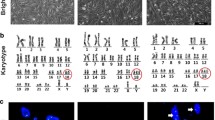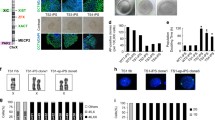Summary
An improved technique for inducing fra(X) expression in cultured cells was obtained by using diazepam for mitotic arrest and 5-fluorodeoxyuridine (FUdR) for the induction of fra(X) expression. The method was developed using cultured fibroblast and urinary cells from fra(X) patients. Prenatal studies were performed on cultured amniotic fluid cells in five pregnancies at risk for fra(X). In two cases the cultured cells showed a 46,XY, fra(X) karyotype. One of the pregnancies was terminated and the diagnosis was confirmed by chromosome studies on several fetal tissues including chorionic villi and by histopathologic changes in the lymphatic vessels of the fetal testes. The fra(X) was also demonstrated in chorionic villi in a case in which amniotic fluid cells were not studied. Chorionic villi were isolated after a spontaneous abortion, the cultured cells had a 45,X karyotype and in addition 5% of the cells were fra(X) positive.
Similar content being viewed by others
References
Andersson LC, Lehto V-P, Stenman S, Badley RA, Virtanen I (1981) Diazepam induces mitotic arrest at prometaphase by inhibiting centriolar separation. Nature 291:247–248
Brookwell R, Daniel A, Turner G, Fishburn J (1982) The fragile X(q27) form of X-linked mental retardation: FUdR as an inducing agent for fra(X)(q27) expression in lymphocytes, fibroblasts and amniocytes. Am J Med Genet 13:139–148
Camerino G, Mattei MG, Mattei JF, Jaye M, Mandel JL (1983) Close linkage of fragile X-mental retardation syndrome to haemophilia B and a transmission through a normal male. Nature 306:701–704
Carr DH, Gedeon M (1977) Population cytogenetic of human abortions. In: Hook EB, Porter IH (eds) Population cytogenetics. Academic Press, New York
Daker MG, Chidiac P, Fear CN, Berry AC (1981) Fragile X in a normal male: a cautionary tale. Lancet 4:780
Fonatsch CA (1981) A simple method to demonstrate the fragile X chromosome in fibroblasts. Hum Genet 59:186
Fryns JP, Van den Berghe H (1982) Transmission of fragile (X)(q27) from normal male(s). Hum Genet 61:262–263
Giraud F, Ayme S, Mattei JF, Mattei MG (1976) Constitutional chromosome breakage. Hum Genet 34:125–136
Glover TW (1981) FUdR induction of the X chromosome fragile site. Evidence for the mechanism of folic acid and thymidine inhibition. Am J Hum Genet 33:234–242
Hogge WA, Schonberg SA, Glover TW, Hecht F, Golbus MS (1984) Prenatal diagnosis of fragile (X) syndrome. Obstet Gynecol [Suppl] 63:19–21
Jenkins EC, Brown WT, Duncan CJ, Brooks J, Ben-Yishay M, Giordano FM, Nitowsky HM (1981) Feasibility of fragile X chromosome prenatal diagnosis demonstrated. Lancet 2:1292
Jenkins EC, Brown WT, Duncan C, Brooks J (1982) Flagile X chromosome prenatal diagnosis. Am J Hum Genet 34-130A
Jenkins EC, Brown WT, Brooks J, Duncan CJ, Ruddeli RD, Wisniewski HM (1984) Experience with prenatal fragile X detection. Am J Med Genet 17:215–239
Koskull H von, Aula P, Trejdosiewicz LK, Virtanen I (1984) Identification of cells from fetal bladder epithelium in human amniotic fluid. Hum Genet 65:262–267
Lubs HA (1969) A marker X chromosome. Am J Hum Genet 21:231–244
Mattei MG, Mattei JF, Vidal J, Giraud F (1981) Expression in lymphocyte and fibroblast culture of the fragile X chromosome: a new technical approach. Hum Genet 59:166–169
Rodeck CH, Morsman JM (1983) First-trimester chorion biopsy. Br Med Bull 39:338–342
Rudelli RD, Jenkins EC, Wisniewski K, Moretz R, Byrne J, Brown WT (1983) Testicular size in fetal fragile X syndrome. Lancet I: 1221–1222
Schmidt A, Passarge E, Seemanova E, Macek M (1982) Prenatal detection of a fetus hemizygous for the fragile X chromosome. Hum Genet 62:285–287
Shapiro LR, Wilmot PL, Brenholz P, Leff A, Martino M, Harris G, Mahoney MJ, Hobbins JC (1982) Prenatal diagnosis of fragile X chromosome. Lancet I:99–100
Simola KOJ (1984) X-linked mental retardation with the marker X chromosome — a clinical and cytogenetic study (Thesis). ISBN 951-99554-7-X, Helsinki, Finland
Sutherland GR (1977) Heritable fragile sites on human chromosomes. Demonstration of the dependence on the type of tissue culture medium. Science 197:265–266
Tommerup N, Poulsen H, Brondum-Nielsen K (1981) 5-Fluoro-2′-deoxyuridine induction of the fragile site on Xq28 associated with X-linked mental retardation. J Med Genet 18:374–376
Turner G, Jacobs P (1983) Marker (X) linked mental retardation. Adv Hum Genet 13:83–112
Webb T, Butler D, Insley J, Weaver JB, Green S, Rodeck C (1981) Prenatal diagnosis of Martin-Bell syndrome associated with fragile site at Xq27-28. Lancet II:1423
Webb CG, Rogers JG, Pitt DB, Halliday J, Theobald T (1981) Transmission of fragile (X)(q27) site from a male. Lancet II:1231–1232
Wilson MG, Marchese CA (1984) Prenatal diagnosis of fragile X in a heterozygous female fetus and postnatal follow-up. Prenat Diagn 4:61–66
Virtanen I, von Koskull H, Lehto V-P, Vartio T, Aula P (1981) Cultured human amniotic fluid cells characterized with antibodies against intermediate filaments in indirect immunofluorescence microscopy. J Clin Invest 68:1348–1355
Author information
Authors and Affiliations
Rights and permissions
About this article
Cite this article
von Koskull, H., Aula, P., Ämmälä, P. et al. Improved technique for the expression of fragile-X in cultured amniotic fluid cells. Hum Genet 69, 218–223 (1985). https://doi.org/10.1007/BF00293028
Received:
Revised:
Issue Date:
DOI: https://doi.org/10.1007/BF00293028




